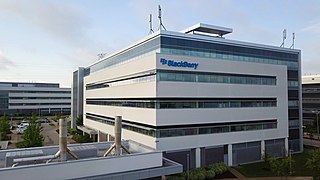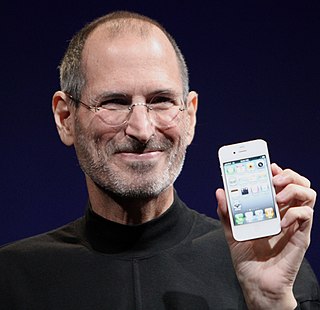Related Research Articles

Apple Inc. is an American multinational technology company headquartered in Cupertino, California. As of March 2023, Apple is the world's largest company by market capitalization, and with US$394.3 billion the largest technology company by 2022 revenue. As of June 2022, Apple is the fourth-largest personal computer vendor by unit sales; the largest manufacturing company by revenue; and the second-largest mobile phone manufacturer in the world. It is considered one of the Big Five American information technology companies, alongside Alphabet, Amazon, Meta, and Microsoft.

A board of directors is an executive committee that jointly supervises the activities of an organization, which can be either a for-profit or a nonprofit organization such as a business, nonprofit organization, or a government agency.

NeXT, Inc. was an American technology company headquartered in Redwood City, California that specialized in computer workstations for higher education and business markets, and later developed web software. It was founded in 1985 by CEO Steve Jobs, the Apple Computer co-founder who had been forcibly removed from Apple that year. NeXT debuted with the NeXT Computer in 1988, and released the NeXTcube and smaller NeXTstation in 1990. The series had relatively limited sales, with only about 50,000 total units shipped. Nevertheless, the object-oriented programming and graphical user interface were highly influential trendsetters of computer innovation.

John Sculley III is an American businessman, entrepreneur and investor in high-tech startups. Sculley was vice-president (1970–1977) and president of PepsiCo (1977–1983), until he became chief executive officer (CEO) of Apple Inc. on April 8, 1983, a position he held until leaving in 1993. In May 1987, Sculley was named Silicon Valley's top-paid executive, with an annual salary of US$10.2 million.
Power Computing Corporation was the first company selected by Apple Inc to create Macintosh-compatible computers. Stephen “Steve” Kahng, a computer engineer best known for his design of the Leading Edge Model D, founded the company in November 1993. Power Computing started out with financial backing from Olivetti and Kahng.
Gilbert Frank Amelio is an American technology executive. Amelio worked at Bell Labs, Fairchild Semiconductor, and the semiconductor division of Rockwell International, and was also the CEO of National Semiconductor and Apple Computer.

BlackBerry Limited is a Canadian software company specializing in cybersecurity. Founded in 1984, it originally developed the BlackBerry brand of interactive pagers, smartphones and tablets. In 2016, it transitioned to a cybersecurity enterprise software and services company under CEO John S. Chen. Its products are used by various businesses, car manufacturers, and government agencies to prevent hacking and ransomware attacks. They include the BlackBerry Cylance, the QNX real-time operating system; BlackBerry Enterprise Server, and a Unified Endpoint Management (UEM) platform.
Jean-Louis Gassée is a business executive. He is best known as a former executive at Apple Computer, where he worked from 1981 to 1990. He also founded Be Inc., creators of the BeOS computer operating system. After leaving Be, he became Chairman of PalmSource, Inc. in November 2004.
Michael Spindler was a German businessman who was president and CEO of Apple from 1993 to 1996. Spindler was born in Berlin.

William Vincent Campbell Jr. was an American businessman and chairman of the board of trustees of Columbia University and chairman of the board of Intuit. He was VP of Marketing and board director for Apple Inc. and CEO for Claris, Intuit, and GO Corporation. Campbell coached, among others, Larry Page, Sergey Brin, Eric Schmidt, and Sundar Pichai at Google, Steve Jobs at Apple, Jeff Bezos at Amazon, Jack Dorsey and Dick Costolo at Twitter, and Sheryl Sandberg at Facebook.
Armas Clifford "Mike" Markkula Jr. is an American electrical engineer, businessman and investor. He was the original angel investor, first chairman, and second CEO for Apple Computer, Inc., providing critical early funding and managerial support. At the company's incorporation, Markkula owned 26% of Apple, equivalent to each of the shares owned by cofounders Steve Jobs and Steve Wozniak.
Ellen Mooney Hancock was a technology manager from the United States who worked for IBM and Apple, among others.

Apple Inc., originally named Apple Computer, Inc., is a multinational corporation that creates and markets consumer electronics and attendant computer software, and is a digital distributor of media content. Apple's core product lines are the iPhone smartphone, iPad tablet computer, and the Macintosh personal computer. The company offers its products online and has a chain of retail stores known as Apple Stores. Founders Steve Jobs, Steve Wozniak, and Ronald Wayne created Apple Computer Co. on April 1, 1976, to market Wozniak's Apple I desktop computer, and Jobs and Wozniak incorporated the company on January 3, 1977, in Cupertino, California.
Fred D. Anderson is an American business executive known for his time with Apple Inc. and as a managing director and co-founder of Elevation Partners.

Steven Paul Jobs was an American businessman, inventor, and investor best known as the co-founder of Apple. Jobs was also chairman and majority shareholder of Pixar, and the founder of NeXT. He was a pioneer of the personal computer revolution of the 1970s and 1980s, along with his early business partner and fellow Apple co-founder Steve Wozniak.
Louis Vachon is a Canadian banker, financier, and business executive. He is currently the chief executive officer of National Bank of Canada, the 6th largest bank in Canada. Louis Vachon announced his intention to retire on October 31, 2021, after nearly 15 years in the role. He has been CEO since 2007, previously serving as the bank's chief operating officer. Before taking a full-time position at the bank, he was the president and CEO of National Bank Financial Group, the 4th largest investment bank in Canada.
Steve Hayden is a well-known figure in the field of advertising. He is the Vice Chairman and Chief Creative Officer of Ogilvy Worldwide. Hayden is one of the most important figures of the late twentieth century advertising, leading creative teams at both Chiat/Day and BBDO on the Apple Computer account.

Jobs is a 2013 American biographical drama film based on the life of Steve Jobs, from 1974 while a student at Reed College to the introduction of the iPod in 2001. It is directed by Joshua Michael Stern, written by Matt Whiteley, and produced by Stern and Mark Hulme. Steve Jobs is portrayed by Ashton Kutcher, with Josh Gad as Apple Computer's co-founder Steve Wozniak. Jobs was chosen to close the 2013 Sundance Film Festival.
Al Eisenstat was an American lawyer and business executive. He served as general counsel, Senior Vice President and board member at Apple Computer.
Marc A. Feigen is an American business executive. As the CEO of Feigen Advisors, he primarily advises CEOs in the Fortune 200, while training and educating new CEOs for the chief executive role. Considered "America's leading coach for CEOs," Feigen has guided more than 35 chief executives of global companies, including Disney's Bob Iger and Ford's Mark Fields.
References
- ↑ Investor Dictionary. "Boardroom coup definition". investordictionary.com. InvestorDictionary.com. Retrieved 2014-10-14.
- ↑ Cambridge Dictionary. "coup definition, meaning". dictionary.cambridge.org. Cambridge University Press. Retrieved 2014-10-10.
- ↑ Listverse (June 2009). "Top 10 Significant Historical Coups d'Etat". listverse.com. Listverse Ltd. Retrieved 2014-10-13.
- 1 2 Auter, P.J.; Boyd, D.A. (1995). "DuMont: The Original Fourth Television Network" (PDF). Journal of Popular Culture. 29 (3): 65. doi:10.1111/j.0022-3840.1995.00063.x . Retrieved 2014-10-13.
- ↑ Weinstein, D (2006). The Forgotten Network: DuMont and the Birth of American Television (1 ed.). Temple University Press. p. 34. ISBN 1592134998.
- ↑ Knoedelseder, William (2012). Bitter Brew: The Rise and Fall of Anheuser–Busch and America's Kings of Beer. HarperCollins. pp. 135–140. ISBN 9780062009272.
- ↑ Hormby, T. "Good-bye Woz and Jobs: How the First Apple Era Ended in 1985". lowendmac.com. Cobweb Publishing Inc. Retrieved 2014-10-10.
- ↑ Hertzfeld, A. "The End Of An Era". www.folklore.org. Creative Commons. Retrieved 2014-10-13.
- 1 2 3 Heilemann, J (September 1997). "The Perceptionist: How Steve Jobs took back Apple". www.newyorker.com. Conde Nast. Retrieved 2014-10-12.
- ↑ Yarow, J (2011-10-26). "Larry Ellison Made Steve Jobs Fall Out Of His Seat Laughing When He Told Him This Story". Business Insider. Business Insider Inc. Retrieved 2014-10-15.
- ↑ Associated Press (1997-09-17). "Apple Formally Names Jobs as Interim Chief". The New York Times. The New York Times Company. Retrieved 2014-10-10.
- ↑ "BIOGRAPHIES: ROBERT C. STEMPEL, GENERAL MOTORS". PR Newswire (26). 1992-10-26. Retrieved 2014-10-13.
- ↑ NBER. "NBER Business Cycle Dating Committee Determines that Recession Ended in March 1991". www.nber.org. National Bureau of Economic Research. Retrieved 2014-10-17.
- ↑ Mantle, J (1995). Car Wars: Fifty Years of Greed, Treachery and Skulduggery in the Global Marketplace. Arcade Publishing. p. 159. ISBN 1559703334 . Retrieved 2014-10-17.
- ↑ Forsyth, R (2012-06-12). "Rangers in crisis: the final whistle sounds on Rangers' 140 years of history". The Telegraph. Telegraph Media Group. Retrieved 2014-10-16.
- ↑ Wilson, R (2013-05-15). "Rangers shareholders stage boardroom coup to oust Malcolm Murray". The Herald. Herald & Times Group. Retrieved 2014-10-17.
- ↑ STV (2013-06-06). "Rangers talks continue over meeting to remove Malcolm Murray". STV Group Plc. HEMEDIA/SWNS Group. Retrieved 2014-10-17.
- ↑ Rusli, E.M.; Connors, W (2014-08-14). "Tech Entrepreneur Chan Pushes Again to Buy BlackBerry". Wall Street Journal. Dow Jones & Company. Retrieved 2014-10-15.
- ↑ The Telegraph (2013-09-23). "The rise and fall of Blackberry". The Telegraph. Telegraph Media Group Ltd. Retrieved 2014-10-15.
- ↑ Chan, R (12 August 2013). "Project BBX - Turnaround Plan for Blackberry". www.slideshare.net. LinkedIn Corporation. Retrieved 2014-10-15.
- ↑ Edwards, J (2013-08-15). "See The Secret, Failed Plan for $6 Billion Boardroom Coup at Blackberry". Business Insider. Business Insider Inc. Retrieved 2014-10-15.